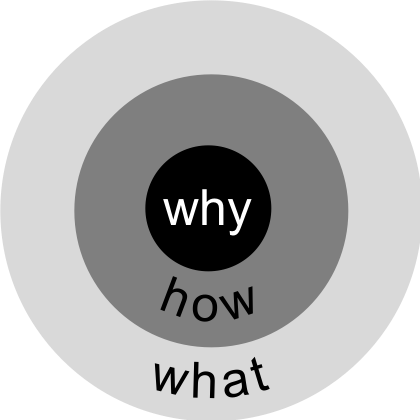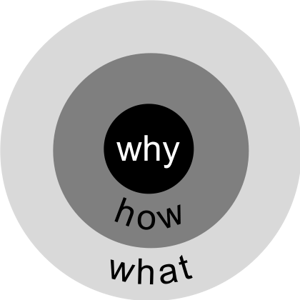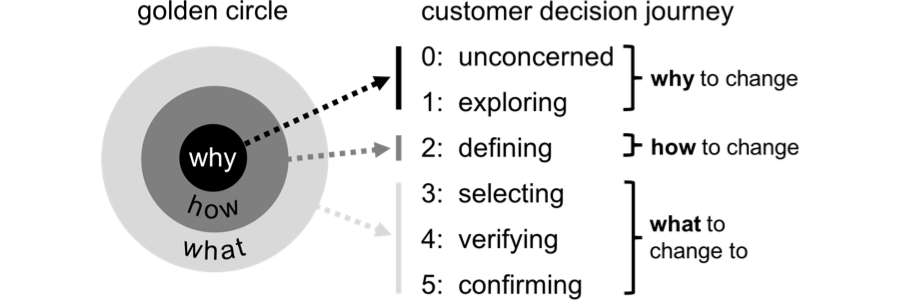Shaping our customer's "why"...
April 30, 2018

 I recently shared my thoughts about applying Simon Sinek’s “Start With Why” concept (also known as The Golden Circle) to the sales process - you can read the article here.
I recently shared my thoughts about applying Simon Sinek’s “Start With Why” concept (also known as The Golden Circle) to the sales process - you can read the article here.
I used Sinek’s framework to make the point that our best customers don’t just buy what we do, they buy into why we have chosen to do it and are prepared to pay a premium for how we do it.
Being able to articulate our why - and going on to explain how our approach is distinctively different and capable of driving superior outcomes for our customer - is a critical advantage in complex B2B sales.
But what about our prospective customer’s why and how - the reason why they believe they need to change and their vision of how they are going to make that change happen? What can we do to influence their thinking?
The answer, it turns out, is a great deal. And it involves applying the principles of the Golden Circle. Exactly how we apply them depends on where our customer is in their buying decision journey. Most successful customer decision journeys evolve through a series of key phases:
- At first our prospective customer is unconcerned or unaware
- Then they turn their attention to exploring the issue
- Then they turn their attention to defining their needs and decision process
- Then they turn their attention to selecting their preferred option
- Then they turn their attention to verifying their choice
- Then they turn their attention to confirming that the project can go ahead
- Then they turn their attention to implementing their chosen solution
It goes without saying that this journey is rarely perfectly linear. The phases can sometimes seem to blur together, and of course our prospective customer can choose to move forwards or backwards, to stay as they are or to abandon the project at any stage. How can we align this with the Golden Circle?

Start with Why (Unconcerned or Exploring)
If our prospective customer is at the very early stage of their journey - if they are either unaware or unconcerned about any of the issues we have chosen to target or have just started to explore them as a result of some recent trigger event - our focus should be on why they need to change.
We need to help them establish a clear value gap between their current situation and their future potential. We need to stretch that value gap by introducing unconsidered or undervalued needs until the contrast between where they are today and where they recognise they need to get to, and the associated case for change, is unarguable.
In doing so, we need to introduce and develop needs that are best satisfied by our core capabilities - but at this early stage, we need to be careful to lead towards our solution, and not with it. A premature product pitch or solution proposal can destroy the momentum that we have carefully sought to build.
During this all-important discovery phase, we need to stick with the problem and progressively develop the consequences and implications until our customer convinces themselves that action is necessary - and if after all our efforts the reason to act still seems vague or weak, we should carefully consider whether the opportunity is likely to lead to a sale.
Turn to How (Defining)
Once both we and our prospective customer believe that the gap between their current situation and future potential is sufficient to justify change, our joint attention must turn to how best to achieve that change.
This needs to include both a clear vision of their future solution, and an agreement about how they are going to decide and how their decision-making process is going to be managed (decision team, process, timing and criteria).
It is particularly critical that we do all that we can to influence our customer’s vision of a solution - and we need to start with the high-level approach (our “how”). What is the best type of solution? The most appropriate architecture? The essential philosophy and key principles upon which the solution must be based?
The decision-making process is a key part of their “how” - who needs to be involved in the decision team? What other internal experts or specialists might have a contribution? What are the key steps and milestones in the decision process? What is the timeframe? And what criteria are going to be used when making the decision - closely related to their high-level vision of a solution.
Whenever we are closely engaged with our customer during their how phase, we give ourselves the opportunity to influence their thinking in our favour. If a competitor takes the initiative during this phase, we may find ourselves at a strong (and potentially permanent) disadvantage.
Now What? (Selecting, Verifying and Confirming)
If we have already helped our prospective customer to shape their why and how, establishing exactly what they need to buy is far easier to influence in our favour. But what if we only become aware of an opportunity once the customer is already in the selecting phase, and have clearly defined exactly what they think they need?
This is most obvious when, for example, we receive an RFP without any prior warning or involvement on our part. Even if the RFP appears to be well aligned with our capabilities, this is a very dangerous stage to enter proceedings.
It is highly likely that other influences (most probably our competitors) have already been at play, and that their fingerprints - whether we can see them or not - are all over the document and the thinking that underpins it.
In issuing the RFP, the customer has already defined what they believe they need to buy. We have had no chance to influence their thinking around either why they need to change or how they need to change.
Make no mistake - when entering the opportunity at this late stage we find ourselves at a huge disadvantage. It is quite probable that they have only called us in because their procurement process requires that they receive a minimum number of competitive bids.
We need to make a very careful and rational assessment whether we should invest the considerable effort required to submit a bid we are unlikely to win (the statistics suggest that our chances are in the low single digits at best).
We are faced with a choice. My inclination has always been to test whether we can work backwards to the customer’s underlying why and how and in doing so at minimum get to better understand their motivations and if possible reshape their thinking in our favour.
This must involve engaging with the key business problem owners directly (and not just via procurement). If we are refused access, we must decide whether to play in game where someone else has established the (quite probably biased) rules.
It’s always best to Start with Why
But of course, this question never need arise if we manage to engage the prospect in the earlier stages of their consideration - while we can still shape their why, how and what. This, of course, requires that we carefully and clearly identify and target the issues we are best at solving, the organisations that are most likely to suffer from them, and the roles most likely to drive the change agenda and that we monitor the trigger events that are most likely to upset or challenge our prospective customer's status quo.
In my previous article, I made the case for Starting With Why in our communications with our market, our customers and our prospects. In this article, I hope I’ve made a case for Starting With Why (or returning to it) in our response to every significant customer opportunity.
We can either influence or be the victims of another parties’ influence. I know which situation I prefer...
IF YOU LIKED THIS, YOU'LL PROBABLY ALSO APPRECIATE:
BLOG: Starting with "Why?"
BLOG: Is your thought leadership really "thought followership?"
BLOG: Discovery - the foundation of B2B sales success
BLOG: The compelling case for hastening slowly
BLOG: The issue with generic "unique value propositions"
BLOG: Are your sales people leading with gain or pain?
BLOG: Encouraging our sales people to think
BLOG: Are you selling "me-too" or "breakthrough"?
ABOUT THE AUTHOR
 Bob Apollo is a Fellow of the Association of Professional Sales and the founder of UK-based Inflexion-Point Strategy Partners. Following a successful career spanning start-ups, scale-ups and corporates, Bob now works with a growing client base of tech-based B2B-focused high-growth businesses, equipping them to Sell in the Breakthrough Zone by systematically creating, capturing and confirming their unique value in every customer interaction.
Bob Apollo is a Fellow of the Association of Professional Sales and the founder of UK-based Inflexion-Point Strategy Partners. Following a successful career spanning start-ups, scale-ups and corporates, Bob now works with a growing client base of tech-based B2B-focused high-growth businesses, equipping them to Sell in the Breakthrough Zone by systematically creating, capturing and confirming their unique value in every customer interaction.


Comments